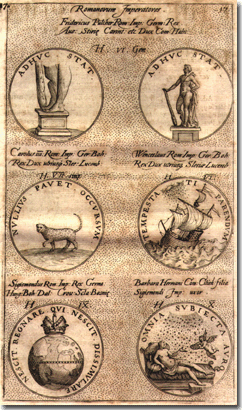|
THIS CD IS PRESENTED as a
continuation of the one dedicated to the Renaissance impresa.
The invention of imprese had become an
exercising of wit linked to the development of the art of
the literary conceit: the yoking of a symbolic image and a witty
sentence provoked a response of admiration and wonder, and, as
the Baroque theory of metaphor advocated, the impresa also
achieved a level of knowledge superior to that allowed to
everyday language. The genre thus extends beyond the Renaissance
into the Baroque, adapting itself to the new aesthetic demands.
But, above all, the Baroque transition consisted of
bringing together, and trying to classify
and comment on the immense corpus of available imprese, as can be seen in this CD.
Well into the seventeenth century, the works
of Menestrier or, more concretely, that of Filippo Picinelli,
had already become exhaustive repertories, of overwhelming
richness and erudition, immersed in the purest Baroque world
vision. The publication of these two authors alone would justify
the existence of the CD. However, lesser-known works are no less
important, such as those by Strada, the first of the great
collections of the Baroque spirit, those of Ferro and Palatius,
with their abundant commentaries, or the eighteenth-century
treasure-house of symbols, Roth-Scholtz. Thus, with the works published
together here for the first time, the reader has available a
global vision of the genre, and, along with the CD of Renaissance
imprese, within easy reach, the entire history of each impresa,
each motto and each image.
In preparation. |
| |

Titles included:
• Strada, Ottaviano, Symbola divina & humana pontificum,
imperatorum, regum, I-III (Prague 1601-1603)
• Ferro, Giovanni, Teatro d’imprese (Venice 1623)
• Picinelli, Filippo, Mundus symbolicus (Venice 1678,
Italian; Cologne 1687,
Latin)
• Menestrier, Claude François (S.J.), Philosophia imaginum (Paris
1682, French; Amsterdam 1695,
Latin)
• Apelles symbolicus I-II (Amsterdam 1699)
• Devises et emblèmes anciennes et modernes, oder Emblematisches
Gemüth-Vereinigung (Augsburg 1695)
• Symbola et emblemata jussu atque auspiciis Czaris Petri totius
Rossiae (Amsterdam 1705)
• Roth-Scholtz, Friedrich, Thesaurus
symbolorum ac emblematum, id est Insignia bibliopolarum et
typographorum ab incunabulis typographiae ad nostra usque tempora (Nuremberg 1730) |